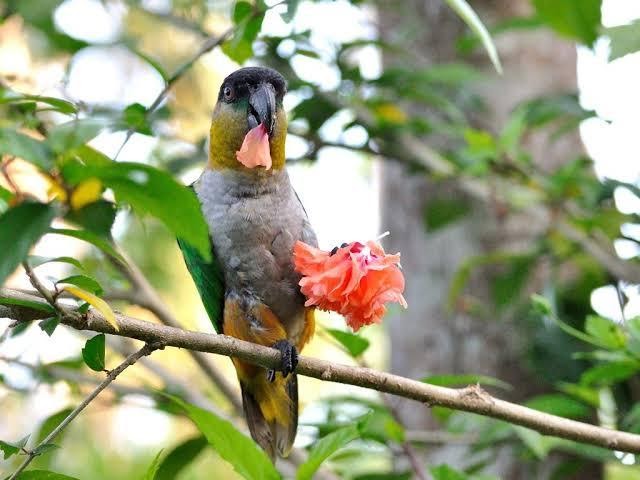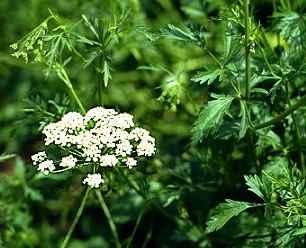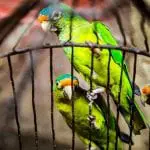
As a pet bird owner, you should mimic your pet’s natural diet as much as possible. A wild bird’s natural diet is far from the diet that captive birds have in such a way that the diet of wild birds is much more varied.
Captive birds may eat more commercially-prepared food with owners adding fruits, vegetables, seeds, and nuts. Wild birds’ diets consist mainly of plant parts. From the plant seeds to the flowers, wild birds can’t help eating their fill. It’s no wonder why some pet owners include natural bird food like edible flowers. So if you’re thinking of expanding your pet bird’s diet, consider these ten edible flowers.
Anise (Pimpinella anisum)

The Anise or aniseed belongs to the family Apiaceae, a flowering plant that grows in the eastern parts of the Mediterranean and Southwest Asia. Anise is a spice that is comparable to the star anise, licorice, and fennel. This plant is widely grown as food and used to flavor alcoholic beverages especially in areas around the Mediterranean. The name anise is from an old French from the Latin term anisum, which means dill.
What does anise look like?
Anise is an annual plant that grows up to 3 feet tall and sometimes taller depending on the area where it’s grown. The leaves along the base of the anise are feathery and are longer with a division on different diameters created by this dense foliage.
Anise flowers have a yellow or white color with 1/8 inch in diameter. This plant is a favorite of the larvae of butterflies and moths such as the wormwood pug and the lime-speck pug.
How to use anise in your pet’s diet
Pet parrots can east anise raw or added to their food. Most pet owners include anise in fruits and vegetable medleys. They may even offer anise flowers by hand with their pets readily savoring every bite. This plant is very safe for birds with no side effects whatsoever.
Anise is aromatic and sweet, and these characteristic flavor has allowed users to distinguish it from its other spices. In most cultures, the whole seed or ground seed is used to make teas and tisanes. There is also a large variety of ethnic candies and sweets are made with anise including the British aniseed balls, black jelly beans, and troach drops.
The most common use of anise is for creating traditional herbal medicine. Anise has a carminative effect. According to historical researchers, anise is a treatment for sleeplessness, as a breath is fresher and is effective for asp bites. In traditional Turkish medicine, anise can stimulate appetite, boost sleep, and relax.
Basil (Ocimum basilicum)

Basil (Ocimum basilicum is also known as “great basil” and is one of the culinary herbs. It is from tropical areas from central America to Southeast Asia. It is used in different cuisines all over the world, and depending on where it’s grown, and the taste can vary from a strong, pungent smell to a sweet-smelling herb.
There are many basil varieties but almost all are called basil. The most common is sweet basil (Genoverse basil), Thai basil (O. basilicum), lemon basil (O. citriodorum) and holy basil (Ocimum tenuiflorum). Most basil varieties are annuals but some are perennially found in tropical and warm places.
What does basil look like?
Basil is mainly used for its leaves but birds will also eat the plant’s flowers. The most common basil are plants that can grow from 30 cm to 150 cm high. Basil leaves are green and oval, but otherwise, the leaves can vary in shape and size depending on where the plant is grown.
Meanwhile, basil flowers are tiny and white. These grow from a central nub which is located along the central stem on top of the plant. Birds may be attracted to the scent of the basil, and depending on the cultivar, there are different scents as well. Experts say that this is because of the number of different kinds of essential oils found in different ratios in the different cultivars. The essential oil coming from the European variety has high amounts of methyl alcohol and linalool.
Basil is a spice native to India and other regions in Africa and Southeast Asia. It is now known and grown around the world.
How to use basil?
Basil is primarily used for cooking, and usually, this is added to the dish at the last moment because too much heat can destroy its natural flavors. You can keep the fresh herb in a small plastic bag and inside a fridge but you can keep these longer in the freezer. Dried basil can easily lose its flavor and very little of it will develop a completely different flavor with some people comparing it to hay.
How to give basil to your pet bird?
Basil leaves and flowers are the most flavorful when these are fresh. If you have a basil plant in your garden, then you must pick leaves and flowers at the last moment to give to your birds. You may cut a small stalk of the basil plant and just leave it inside the bird’s cage. No need to pluck the flowers out. Just hang the branch from a height inside the cage.
Don’t worry about side effects because the basil is non-toxic, and thus your pet and his friends can have a feast. And since the basil is known for its therapeutic properties, you may place a small branch of basil flowers inside your pet’s cage if you find it feeling lethargic, weak and with poor appetite.
Calendula (Calendula officinalis)
Calendula is also called pot marigold, common marigold, ruddles, or Scotch marigold. This is a plant that originated from southern Europe but because of its extensive history of cultivation, its exact origin is still unknown. You can also find calendulas in northern Europe in southern England and warm areas of the world.
What does calendula look like?
A calendula plant is a short-lived, perennial plant that can grow up to 31 inches tall with erect stems. This plant has hairy oblong-shaped leaves that are 2 to 7 inches long. The calendula flowers are yellow with thick flowerheads measuring 4 to 7 cm in diameter with two sections of hairy bracts. In the wild, the flowers have a ring of small flowers that surround the central disc of florets. These are tubular in shape and are hermaphrodites with a brighter orange-yellow shade. These flowers are present all year, especially when it is grown in good conducive conditions. Meanwhile, the calendula fruit is a thorny dry fruit.
Calendulas are a part of the diet of many larvae of the Lepidoptera species like the cabbage moth, large yellow underwing, and the gothic moth. Because of this, wild birds eat this plant and not just its flowers.
How to use calendulas?
Calendula florets are edible and may be used to add more color to salads or as a garnish like saffron. The leaves are not edible, though. People use calendulas as pot herbs to make salads.
On the other hand, the flowers are common in ancient Greek, Indian, and Roman, Middle Eastern cultures as a medicinal flower. The flowers may also be used to make dyes to color food, cosmetics, and fabrics. Oil of the calendula is also extracted from the flowers and this has natural protective properties.
How to add calendulas to your pet’s diet?
To add calendulas, make sure that the flowers you will feed your birds are from a safe, organic garden. To prepare the plant, cut the flowers from the plant but make sure that you leave a long stalk or stem from the flowers. Use the stalk to attach the flowers from a height inside the cage. Just stick the flowers along the sides of the cage or you can cut the flower directly below the bud (but don’t take the flower apart). Finally, if you have branches, stems, and natural perches inside your pet’s cage, you can stick the flower from these as well.
Flowers like the calendula can make a lot of mess as your bird tries to pick on it, so be patient in cleaning your bird’s cage.
Dandelion (Taraxacum)
Taraxacum is known as a large genus of flowering plants with species known as dandelions. This plant is native to North America and Eurasia. Some species were introduced from their native continent Europe and are now growing wild everywhere.
Almost all the species of dandelions are edible. And because of the abundance, the dandelion is regarded as one of the most important pollinators of early spring nectars. Most species of the dandelion produce seeds asexually or without the use of pollination. The resulting plant is genetically identical to its parent or a clone of its parent.
What do dandelions look like?
The species that belong to the Taraxacum are perennial, herbaceous and tap-rooted plants that live in temperate areas of the Northern Hemisphere. Generally, the leaves of the dandelion can grow from 5 to 25 cm long, lobed and has basal rosette just above the taproot. The heads are yellow to orange and are open during the day and then close at nighttime. These are single from a hollow stem that has no leaves, which can grow up to 10 cm long or longer.
The stems and the leaves of the dandelion secrete a white and milky substance when opened. Usually, a rosette can produce many flowering stems. The flower heads come with ray florets. The heads also mature to make spherical-shaped heads, which are mostly referred to as blowballs. These heads come to contain single-seeded fruits or achenes. Each of these has a pappus of hair-like material that catches the wind to be dispersed to many long distances.
How to use a dandelion?
Raw dandelion greens are great sources of Vitamins A, K, and C, calcium, iron, potassium, and manganese. Raw greens have 86% water, and the rest is made of carbohydrates, fat, and protein. All the plant parts are edible and are very nutritious. The flowers are eaten before these become seed heads. The fluffy parachutes are edible but tasteless.
How to feed dandelions to your pet birds?
The flowers of the dandelion, as well as the seeds, are known as important food sources for many types of birds. It is very easy to find dandelions in the wild or even in your garden, but please look for flowers that are not affected by pesticides or herbicides.
Take note that in some places, the dandelion is known as an invasive plant. This can cause invasion and infestation to crops and thus are destroyed using pesticides and herbicides. Don’t harvest dandelion as food for your pet birds if this plant is classified as a noxious weed in your area.
To feed flowers to your pet, gather flowers before these turn into seed heads. Although it may not matter since birds also eat the seeds, the flowers are known to be more flavorful.
Hibiscus
Hibiscus refers to a genus of flowering plants belonging to the mallow family and hence the name rose mallow. This genus is large with hundreds of species belonging to places with warm and temperate, subtropical, and tropical climates in the world. The members of this species are known for their showy flowers and are known simply as hibiscus. Other names of this plant are tropical hibiscus, hardy hibiscus and rose of Sharon.
Several species of the hibiscus are grown as ornamental plants, while some grow this plant to be used as teas. Hibiscus tea is served hot or cold and comes with high vitamin C content, red color, and tarty taste.
What does hibiscus look like?
Hibiscus plant range in height and appearance and their flowers also vary in appearance as well. The most common has alternate leaves that are oval with a toothed margin. The flowers are very large, trumpet-shaped and have five petals and sometimes more. The flowers vary in color with white, pink, red, peach, orange, yellow, and purple as the most common. The colors of the flowers change as the plant ages. The fruit of the hibiscus is a dry capsule with five lobes with several seeds inside each lobe.
How to use hibiscus?
The hibiscus is a versatile plant and has many different uses in many cultures around the world. In Hindu worship, it is used as an offering. It can be used to make bubbles in the Philippines. Hawaiian girls use the hibiscus flower to adorn their hair. Wearing the flower on the right ear means that the female is single.
Hibiscus plants are often used in landscaping because of their beauty and hardiness. A species is used to make kenaf or paper while the flowers can be made into teas. Dried hibiscus is edible and is used in salads, garnish, or desserts.
How to feed hibiscus to your pet birds?
There’s no need to prepare hibiscus flowers to feed to your pets. Just remove the flower from its stalk and place it somewhere inside your pet’s cage. You can place a few along the perches and branches or just scatter some on the floor.
It’s important to harvest hibiscus from sources that are not sprayed with chemical pesticides and herbicides. Since this is a common landscaping plant, gardeners may be using chemicals to preserve gardens. You should only get hibiscus flowers from safe gardens and parks.
Honeysuckle (Lonicera)
The honeysuckle shrub or vine belongs to the Caprifoliaceae family and is native to North America and Eurasia. There are 180 or more species of honeysuckle in these regions, and the most abundant are the common honeysuckle, Japanese honeysuckle, Chinese honeysuckle, coral honeysuckle, and trumpet honeysuckle. Meanwhile, the Japanese honeysuckle is one of the most aggressive and invasive species considered as a pest in North America, South America, Europe, Africa, and Australia. Some species are fragrant and lovely and thus cultivated as garden plants.
What does honeysuckle look like?
The honeysuckle is a tender shrub with opposite leaves, with some plants deciduous while some are evergreen. Most have sweetly scented flowers with sweet and edible nectar. Most honeysuckle flowers come in clusters of two. Both of these are shrubby with hardy stems used to bind packages.
The fruit of the honeysuckle is red, black, or blue and has a spherical or elongated shape with seeds. In most honeysuckle species, the fruit is slightly poisonous but most are edible and are cultivated for home or commercial uses. These berries are very bright and attractive especially to birds and thus were spread outside their natural habitat.
How to feed honeysuckle to your pet birds?
Choose only honeysuckle species that are safe to eat also pick flowers from a plant that has not been sprayed with fertilizer or herbicides. Cut the flowers and string them together with needle and thread. Place these on top of a perch or a branch so your pets can fly by and eat them. You may also place flowers all over the branches or create a flowery feast by combining honeysuckles with other flowers like hibiscus and sunflowers.
Passionflower (Passifloraceae Passiflora)
Passionflower is also known as passiflora or passion vine. It is a genus with 550 species of flowering plants. These species are mostly vines but some are trees or shrubs. The plant is woody while some are herbaceous. The flowers are showy, regular with a bright corona. The passionflower will ripen to fruit with many seeds.
What does passionflower look like?
The appearance of a passionflower varies from species to species. It is known to be one of the most diverse in all genera. Leaves also vary from lobed to unlobed and may even be found on the same plant.
The bracts of the flower are covered with hairs that give off a sticky liquid. Small insects may get stuck from this fluid and thus, experts call the passion plant as a protocarnivorous plant. Some passion flowers are invasive species such as those found in Brazil, Hawaii, and Spain.
Meanwhile, some passionflower species are endangered due to habitat destruction such as passion flowers from Chile and Venezuela
How to use passionflower?
Some passionflower species are also cultivated for their flowers and fruit. These are used mainly as ornamental or garden plants, while some species are used as food. The passion fruit is eaten raw or juiced. This flower is also used in traditional medicine. Some species are used as teas because of their sedative powers and as a dietary supplement.
How to feed passionflower to your pet birds?
Your pets will love almost all species of passionflower and even passiflora fruit. But, be wary of plants grown in treated soil, pesticides and herbicides. Harvest flowers in a clean and safe environment. You can serve flowers strung together and hung inside your pets’ cage. You can mix this flower with other edible flowers to make a delicious treat. If you want to serve passion fruit, cut it open, and remove the seeds. Dice the fruits or just leave one open inside the birdcage.
Petunia (Petunia spp.)
The petunia comes in 20 different species of plants that are native to South America. Petunia comes from the French word petun, which means tobacco. Most of the petunias in gardens these days are hybrids.
What does petunia look like?
Petunias come in different colors, and the structures are tubular. Most plants are the product of insect pollination while a rate species called the P. exserta is pollinated by the hummingbird.
How to use petunia?
Petunias are mainly ornamental because of its lovely colors, shapes, and sizes. You will find a wide range of species made by the Petunia x atkinsiana species. Meanwhile, the flowers were also used to create powerful magical drinks.
How to feed petunia to your pet birds?
Petunias can be easily cultivated in any garden, and this is the best way to get a steady supply for your pet. Because this is an ornamental plant, gardeners may spray pesticides and herbicides on their plants. Eating flowers from this plant can be very dangerous to your pets.
Prepare petunias by cutting the flower directly under it and then stringing it with other edible flowers. You may also place a few of the branches located inside the cage. Petunias can wilt easily, so serve only a few to your pets. Flowers should only be given as treats.
Roses or rose hips (Rosoideae Rosa)
The rose is a woody perennial plant with more than 300 species and thousands of different cultivars. The rose plant can be erect, trailing or climbing plants and all are covered with sharp thorns. The rose flower comes in different colors, from white to deep red.
Most rose species are from Asia, while some are from Europe, Africa, and North America. All of the species are fragrant and are cultivated for their beauty.
What do roses look like?
The rose plant’s leaves are long and pinnate with serrated margins. Most species are deciduous while some are evergreens. The flowers usually have five petals and five sepals. Wildflowers are mostly insect-pollinated.
The fruit of a rose plant is called the rosehip. Most domesticated cultivars don’t bear a fruit because their flowers have tightly-packed petals making pollination difficult. The dog rose, and the rugosa rose is high in vitamin C and is mostly eaten by birds like waxwings and thrushes. The droppings of these birds disperse the seeds wherever they go.
How to use roses?
Roses are not just ornamental plants but are also used to make other products like perfumes, makeup, skincare products, and as cut flowers. Some roses are colored with dyes to make different colored roses.
Rose hips are edible and are made into jelly, soup, marmalade, and jams. Rosehip syrup comes from pressed rosehips, and these are also useful to make rosehip oil.
How to feed roses to your pet birds?
Don’t feed your pets wild roses or rosehips because these can be hosts to diseases. Never give roses that were processed as cut flowers because some florists preserve flowers using chemicals that can harm your pet. Is it safe to harvest roses in your garden? Yes, if you don’t use pesticides and herbicides on your plants. Also, check the flowers for fungus, molds, and other pests before giving to your pet bids.
You can hang roses from the branches inside the cage or string these together with other edible flowers.
Sunflowers (Helianthus annuus)
The sunflower is a large, bright flower known for its oil and fruits. It is one of the most commonly used flowers to feed wild birds and livestock. This plant was first domesticated in Africa and was exported to Europe from the Americas during the 16th century. This was the start of the spread of sunflower oil for cooking.
The name sunflower may have been derived from the appearance of the flower, which looks like the sun. It was also thought that the flower slowly turns its head towards the sun as it moves across the sky.
What do sunflowers look like?
The sunflower plant has an erect and hairy stem that can grow as high as 9.8 feet! The tallest one is 30.1 feet. The leaves are broad, coarse and alternate. The flower is the flower head with small five-petaled flowers or florets. The color of the flower head may be yellow, orange, or red.
How to use sunflowers?
The sunflower seed is a snack food that may be eaten roasted with or without seasoning. The sunflower seeds can be made into peanut butter, whole seed bread, and as a part of many different dishes. Sunflower oil is used in cooking and as a carrier oil for biodiesel and margarine.
How to feed sunflowers to your pet birds?
Sunflower seeds are mostly part of a bird’s commercially-prepared food products, and thus your pet may already be familiar with it. The flower or flower head may be cut and placed inside the cage. Your pets can fly down and pick the flowerets and eat them. You can hang sunflowers inside their cages or use these as treats when your pet is out of the cage and training with you.
As always, choose sunflowers that are grown without any pesticides or chemicals which can hurt your pet. Also, remove leftover flower heads and seeds to prevent pests from entering the birdcage.
Conclusion
Birds naturally eat flowers in the wild, and no wonder they are easily receptive when you serve them this food. But be careful about where to get your flowers. Make sure to harvest from safe gardens or better yet, grow your flowers so your pet will have an endless supply of food. These flowers are edible and nutritious but should only be a part of a well-rounded diet consisting of other foods like fruits, vegetables, sprouts, nuts, and commercial bird food.


